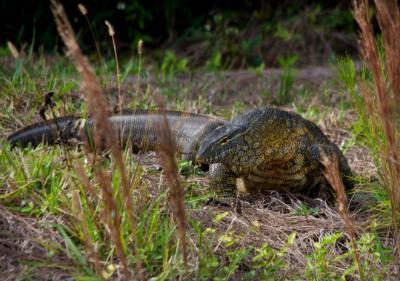New outreach strategy sets blueprint for detecting invasive species in Florida
Invasive species in Florida like Nile monitors and Argentine black-and-white tegus pose a growing threat to the Sunshine State’s environment, economy and public safety. South Florida’s warm climate, disturbed habitats and bustling pet trade have made it a hotspot for these non-native, cryptic reptiles. However, finding these elusive creatures has always been a challenge – until now.
University of Florida researchers are showcasing how a focused outreach initiative in Palm Beach County has led to a successful increase in reports of invasive reptiles in Florida. The findings are documented in the latest study published in Scientific Reports and authored by researchers at UF/IFAS Fort Lauderdale Research and Education Center.
of Florida researchers are showcasing how a focused outreach initiative in Palm Beach County has led to a successful increase in reports of invasive reptiles in Florida. The findings are documented in the latest study published in Scientific Reports and authored by researchers at UF/IFAS Fort Lauderdale Research and Education Center.
This initiative addresses the growing threat posed by non-native reptiles to the environment, economy and public health in South Florida.
“When species are rare and hard to find, it helps to get a lot of eyes looking for them. Targeted outreach does that,” said Frank Mazzotti, professor of wildlife ecology and lead author of the study. “Community involvement not only proves to help us find invasive species but provides opportunities to increase awareness as well.”
 Targeted outreach involves delivering specific messages to audiences in designated locations to achieve desired outcomes. In this case, the goal was to encourage residents and workers in the C-51 Basin and surrounding areas in Palm Beach County to report sightings of large invasive lizards, such as Nile monitors, to the Florida Fish and Wildlife Conservation Commission (FWC) IVE-GOT1 hotline or through EDDMapS.
Targeted outreach involves delivering specific messages to audiences in designated locations to achieve desired outcomes. In this case, the goal was to encourage residents and workers in the C-51 Basin and surrounding areas in Palm Beach County to report sightings of large invasive lizards, such as Nile monitors, to the Florida Fish and Wildlife Conservation Commission (FWC) IVE-GOT1 hotline or through EDDMapS.
EDDMapS is a website that maps the distribution of non-native species in the United States and Canada through documented reporting provided by experts and the general public throughout those two countries.
From 2018 to 2020, the project’s targeted outreach efforts reached over 112,000 people and households through various methods including in-person, online and virtual.
Subsequently, researchers engaged 53,657 people on social media, presented webinars to 229 individuals, sent email newsletters to 34,350 recipients, conducted an online survey with 520 participants and potentially reached up to 20,000 people through print media.
These efforts led to 55 reported sightings of Nile monitors and Argentine black and white tegus in Palm Beach County and the surrounding area, with 32 of these reports directly attributed to UF/IFAS’ outreach.
The data gathered by the project showed that newspapers brought in the most reports, helping UF/IFAS researchers identify more invasive reptiles. In-person methods, such as door hangers and presentations allowed for face-to-face engagement, making residents feel more confident in reporting what they spotted. Social media proved to be a time-efficient way to spread the message far and wide, allowing even more people to become part of the effort.
“We learned valuable lessons regarding the effectiveness of different targeted outreach methods for detection of invasive wildlife,” said Mazzotti. “Targeted outreach can be done by a broad community of environmental educators. These methods can be replicated in other locations with different target species, which could lead to an increase in local understanding of the status and range of invasive species in Florida, and ultimately improved management and monitoring programs.”
Para accesar a este contenido en español, por favor utilice este enlace.
